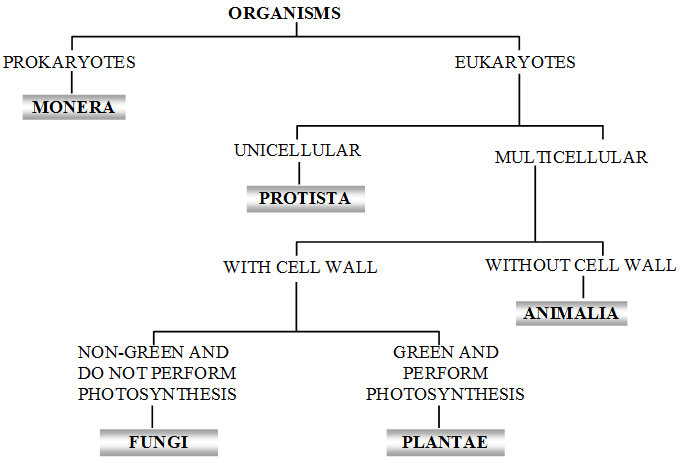What is Binomial Nomenclature
It was Proposed by Carolus Linnaeus.
- According to this system of nomenclature, each animal or plant is given two names : the first one is the generic name and the second one is the name of the species.
- Scientific names are always in Latin.
- The first letter of the generic name is always capitalized and that of the specific name is written in small letter. For example, the scientific name of frog is Rana tigrina, in which Rana is the generic name and tigrina is the name of the species.
Two Kingdom Classification :
Father of taxonomy – Carolus Linnaeus. He preposed following kingdoms.
- Plantae : Which included Bacteria, Fungi, Algae, Mosses, Liverworts, Ferns, Conifers and Flowering plants.
- Animalia : Included Protozoan, Sponges, Jelly fishes, Worms, Crabs, Insects, Millipedes, Centipedes, Spiders, Snails, Star fishes, Snakes, Frogs, Birds and Mammals.
Three Kingdom Classification :
This was suggested by german biologist, E. Haeckel in 1866. As some microscopic single celled forms were unlike plants or animals altogether and could not be placed in earlier system, thus three kingdom system was proposed. It includes
- Plantae
- Animalia
- Protista: contained all single celled organisms like protozoans and unicellular algae.
Four Kingdom Classification :
This was developed by Copeland in 1966.
As prokaryotes (Organisms without true nucleus) were different from eukaryotes (organism with true nucleus), a new group, monera was formed.
Five Kingdom Classification :
This most favoured scheme was proposed by R.H. Whittaker in 1969. Fungi could not find a suitable place in earlier system of classifications and thus whittaker’s five kingdom theory found favour amongst most biologists.
This classification includes :
- Plantae
- Animalia
- Fungi
- Protista
- Monera.
Six Kingdom Classification :
It was proposed by Woese, Kandler and Wealis (1990). They divided monera into Archae bacteria and Eubacteria.

1. Kingdom : Monera
Kingdom, Monera includes the most ancient, the smallest, the simplest and the most plentiful prokaryotes. These organisms are most primitive. Monerens are characterized by the following.
- The organisms are mostly unicellular. The cyanobacteria are, however, filamentous.
- They do not have a definite nucleus. The genetic material is a circular, double-stranded, helical DNA (Deoxyribonucleic acid) not enclosed by a nuclear envelope. Such organisms which do not have a definite nucleus are called prokaryotic.
- The cytoplasm of organisms is devoid of membrane bound organelles, i.e., mitochondria, plastids, Golgi apparatus, lysosomes, endoplasmic reticulum, centrosome, etc. are lacking. However, the ribosomes are present.
- Cell wall is generally present. some of prokaryotes do not have cells wall.
- The mode of nutrition of organisms in this group can be either : (i) Autotrophic (i.e., synthesize their own food by photosynthesis) or (ii) Heterotrophic (i.e. get their organic food from the environment).
- Single stranded flagella are present in many monerans.
Kingdom Monera includes true bacteria, actinomycetes, cyanobacteria or blue green algae, mycoplasma and archaebacteria.
2. Kingdom : Protista
Kingdom Protista includes unicellular eukaryotic organisms. They are characterized by the following :
- Protists are mostly aquatic and live wherever there is water.
- The cell structure is typically eukaryotic. The protoplasm is surrounded by a distinct plasma membrane. In addition, some protists have an outer covering of pellicle, cuticle, shell or cellulose wall.
- The genetic material is the linear, double-stranded, helical DNA, complexed with proteins, organized into dinstinct chromosomes. The chromosomes are enclosed by nuclear envelope. Nucleolus is present.
- The cytoplasm contains memberane bound organelles such as mitochondria, plastids, Golgi bodies, endoplasmic reticulum, ribosome, etc.
- Their mode of nutrition can be autotrophic or heterotrophic.
- Motile protists move from one place to another with the help of pseudopodia, flagella or cilia.
Unicellular protists have been broadly divided into three major groups.
- The protistan algae – eg., euglena, diatoms
- Slime moulds
- Protozoan protists – amoeba paramecium
3. Kingdom : Fungi
- Fungi are multicelled, non photosynthetic organism.
- Some fungi are microscopic while others can be seen with the naked eyes.
- Some fungi are unicellular while others are multicellular consisting of numerous filaments known as hyphae.
- The hyphae branch profusely and from a network called mycelium.
- Since fungi Lack chlorophyll they can’t synthesise their own food and therefore they either lead a parasitic or sporophytic life.
- The Parasitic fungi may infect the host superficially or they may penetrate the host tissues (Ectoparasite and endoparasite).
- The fungi develop haustoria which help in absorption of nutrients from the host. Ex. mucor
4. Kingdom : Plantae of Plant Kingdom
5. Kingdom : Animalia or Animal Kingdom
